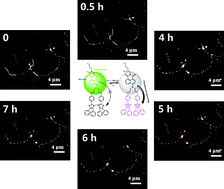Single-wavelength-controlled in situ dynamic super-resolution fluorescence imaging for block copolymer nanostructures via blue-light-switchable FRAP†
Abstract
Photoswitchable fluorophores are promising in single-molecule optical devices and super-resolution fluorescence imaging, especially in single-molecule photo-activated localization microscopy (PALM) or stochastic optical reconstruction microscopy (STORM). However, the scarcity of current photoswitchable fluorophores stimulates researchers to develop complicated optical systems and processing software, in accordance with the limited photoswitchable fluorescent proteins and organic fluorophores. Previous efforts to develop synthetic photoswitchable fluorophores have exhibited their promising potential in super-resolution fluorescence imaging. Here, we have designed and synthesized a fluorescence molecular switch with reversible green emission, a napthalimide–hexaarylbiimidazole conjugate (NI-N-HABI), which exhibits strong fluorescence in the emissive state, with fast thermal fading of the photochromism and spontaneous fluorescence recovery after photobleaching (FRAP) induced by blue-light. The photoswitchable fluorophore enables the red-edge wavelength of the optical response to red-shift from the initial near-UV region at less than 400 nm, to 500 nm. The relatively fast fading speed of NI-N-HABI and its sensitivity to longer blue-light irradiation (400–500 nm) have allowed simplification of the optical microscopic system from a two-wavelength laser source to a single-wavelength laser. We applied NI-N-HABI in single-wavelength-controlled in situ dynamic super-resolution fluorescence imaging for the self-assembly and solvent annealing of amphiphilic block polymers, with 50 nm of optical resolution. Single-wavelength-controlled dynamic super-resolution fluorescence imaging facilitates nanoscale optical visualization for the dynamic physical and chemical fluctuation processes of stimuli-responsive nanostructures.



 Please wait while we load your content...
Please wait while we load your content...